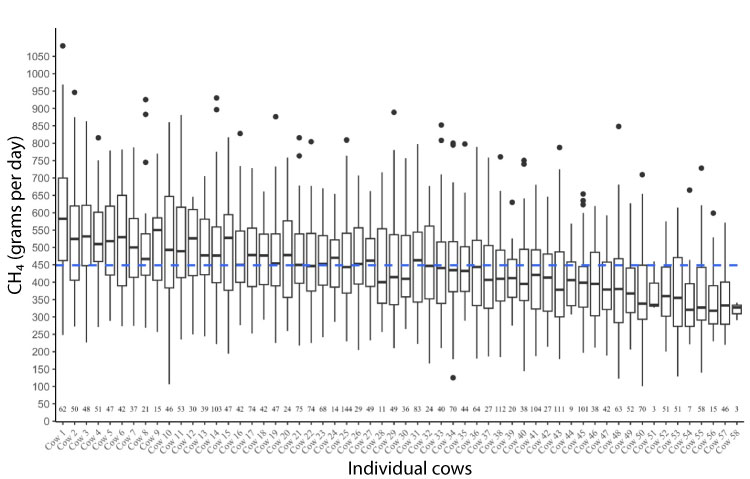
Can we select cows for reduced methane production?
This is a question that genetics researchers around the world are tackling, as we seek to reduce the environmental footprint of dairy farming. Dairy cattle account for about 26% of U.S. methane emissions, and mitigation of enteric emissions is crucial for the dairy industry to meet its greenhouse gas reduction goals. Furthermore, enteric methane represents a loss of gross energy that could otherwise be used for growth or milk production. The challenge is to identify effective and affordable strategies to reduce methane emissions through nutritional management, selective breeding, and other interventions.
It may be surprising to learn that significant genetic differences exist between animals in methane production (total methane emissions per day), methane intensity (methane per unit of energy-corrected milk), and methane yield (methane per unit of dry matter intake). The graph below shows the variability in methane production observed within a recent batch of 58 mid-lactation multiparous Holstein cows at the University of Wisconsin (UW)-Madison Emmons Blaine Dairy Cattle Research Center in Arlington over a six-week period. As you can see, the methane production of individual cows in the same pen and with similar milk yield ranged from 350 to 550 grams of methane (CH4) per day.

With a new Greener Cattle Initiative grant from the Foundation for Food & Agriculture Research, Francisco Peñagaricano and his colleagues at UW-Madison, as well as collaborators at Iowa State University, Michigan State University, University of Florida, and the USDA Agricultural Research Service, will measure methane production in 3,800 Holstein cows for the purpose of developing a genomic reference population for methane-related traits. Relationships of methane production, methane intensity, and methane yield with key traits such as milk yield and feed efficiency will be evaluated, and researchers will use mid-infrared spectral data to study associations of methane emissions with detailed differences in milk composition. They will also examine differences in the rumen microbial populations of cows with significantly higher or lower enteric methane emissions than their contemporaries.
The ultimate goal of this project is to help the Council on Dairy Cattle Breeding develop a national genetic evaluation system that will allow dairy farmers to select cows that produce less methane. This, in turn, will enhance the environmental sustainability of dairy production.







